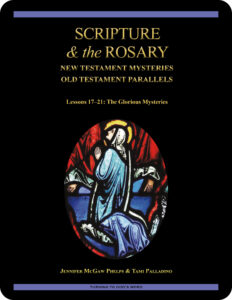 Scripture & the Rosary:
Scripture & the Rosary:
New Testament Mysteries,
Old Testament Parallels
The Third Glorious Mystery
Lesson 19 A Sound Came from Heaven Like the Rush of a Mighty Wind
the Acts of the Apostles 2:1–4
the Acts of the Apostles 2:14–18
the Book of Isaiah 6:1–9
Revised Standard Version Catholic Edition (RSVCE)*
New American Bible Revised Edition (NABRE)*
Catechism of the Catholic Church
Rosarium Virginis Mariae (Rosary of the Virgin Mary)
ex libris (in our library)
cross references for Scripture & the Rosary
next lesson: I Go to Prepare a Place for You
This material coordinates with Lesson 19 on pages 72–75 in Scripture & the Rosary: New Testament Mysteries, Old Testament Parallels.
And Mary said, “My soul magnifies the Lord, and my spirit rejoices in God my Savior,
for he has regarded the low estate of his handmaiden.
For behold, henceforth all generations will call me blessed;
for he who is mighty has done great things for me, and holy is his name.”
—the Gospel According to Luke 1:46–49
welcome to our in-depth study of Scripture & the Rosary
We invite groups and individuals to become acquainted with Turning to God’s Word Catholic Bible  studies through
studies through  Scripture & the Rosary: New Testament Mysteries, Old Testament Parallels, which has been granted an imprimatur. Although no longer available in print, the first six lessons can be downloaded from our website. The remaining 20 lessons are posted throughout the liturgical year along with their related online study pages. Click here to access Lesson 17 through Lesson 21. If you have a Bible-study question or comment, you can contact our authors any time by using one of the “ask us your question” or “what do you think” buttons on any online study page.
Scripture & the Rosary: New Testament Mysteries, Old Testament Parallels, which has been granted an imprimatur. Although no longer available in print, the first six lessons can be downloaded from our website. The remaining 20 lessons are posted throughout the liturgical year along with their related online study pages. Click here to access Lesson 17 through Lesson 21. If you have a Bible-study question or comment, you can contact our authors any time by using one of the “ask us your question” or “what do you think” buttons on any online study page.
open with prayer
It’s always wise to begin any Bible study with prayer, whether reading the Scriptures alone or meeting with others in a discussion group. You can pray using your own words or use one of the opening prayers on our website. We especially like the following:
Lord Jesus, you promised to send your Holy Spirit to teach us all things.
As we read and study your word today,
allow it to touch our hearts and change our lives. Amen.
making connections—purified to speak for God
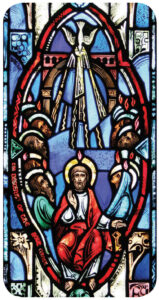 Lesson 19 in Scripture & the Rosary: New Testament Mysteries, Old Testament Parallels looks at the Third Glorious Mystery, the Descent of the Holy Spirit. The New Testament text is from Acts of the Apostles 2:1–4 and 2:14–18, with the Old Testament parallel from the Book of Isaiah 6:1–9. There’s considerable overlap between the images used for God and the Holy Spirit in Lesson 19 in Scripture & the Rosary: New Testament Mysteries, Old Testament Parallels and the same images that appear in previous lessons. L
Lesson 19 in Scripture & the Rosary: New Testament Mysteries, Old Testament Parallels looks at the Third Glorious Mystery, the Descent of the Holy Spirit. The New Testament text is from Acts of the Apostles 2:1–4 and 2:14–18, with the Old Testament parallel from the Book of Isaiah 6:1–9. There’s considerable overlap between the images used for God and the Holy Spirit in Lesson 19 in Scripture & the Rosary: New Testament Mysteries, Old Testament Parallels and the same images that appear in previous lessons. L earn more about the prophet known as Proto- (First) Isaiah or Isaiah of Jerusalem in Lesson 20 Isaiah Foresees Immanuel’s Birth in the Turning to God’s Word Catholic Bible study Thus Says the LORD: God Speaks Through His Servants the Prophets—Volume I: A Kingdom Divided.
earn more about the prophet known as Proto- (First) Isaiah or Isaiah of Jerusalem in Lesson 20 Isaiah Foresees Immanuel’s Birth in the Turning to God’s Word Catholic Bible study Thus Says the LORD: God Speaks Through His Servants the Prophets—Volume I: A Kingdom Divided.
let’s look at the new in the light of the old
As you read through this lesson’s selected passages from the New and Old Testaments, ask yourself what these two biblical accounts have in common. Additional in-depth questions can be found on pages 72–75 in Scripture & the Rosary: New Testament Mysteries, Old Testament Parallels. Clicking on the New and Old Testament stained glass windows will enlarge the art. The same art also illustrates Lesson 19 in Scripture & the Rosary: New Testament Mysteries, Old Testament Parallels.
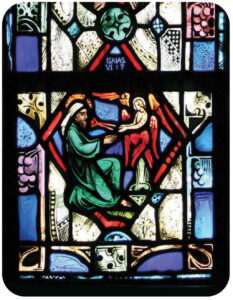 ? Consider why biblical authors employ so many different images when writing about God and the Holy Spirit.
? Consider why biblical authors employ so many different images when writing about God and the Holy Spirit.
? What are some points of contact between the Old Testament accounts of the prophets Elijah, Elisha, and Isaiah?
? What’s similar about Isaiah and the early followers of Jesus who are filled with the Holy Spirit at Pentecost?
? What’s the purpose of a prophet? The Turning to God’s Word Catholic Bible study Thus Says the LORD: God Speaks Through His Servants the Prophets—Volume I: A Kingdom Divided focuses on the prophets who were active in Judah and Israel prior to the Babylonian Exile.
? For what purpose do you think it is that Jesus’ followers are filled with the Holy Spirit?
? How is fire involved in Isaiah’s call as a prophet and in the Descent of the Holy Spirit?
? What ramifications does the Descent of the Holy Spirit at Pentecost have for Christians?
? Look at the pictures of the stained glass window panels  on pages 72 and 74 in Scripture & the Rosary: New Testament Mysteries, Old Testament Parallels. What similarities do you see between the depictions of these New and Old Testament scenes?
on pages 72 and 74 in Scripture & the Rosary: New Testament Mysteries, Old Testament Parallels. What similarities do you see between the depictions of these New and Old Testament scenes?
supplemental Scripture
The Old Testament parallel text for this lesson is Isaiah’s call to be a prophet, which is found in the sixth chapter in the Book of Isaiah. Because events described in the Book of Isaiah occurred over a time period far surpassing any normal lifespan, Scripture scholars are in some disagreement about how best to attribute the work. What they do agree on, however, is that a man called Isaiah of Jerusalem probably  wrote the first 39 chapters of the book. Sometimes he’s referred to as Proto- or First Isaiah. His writing includes a dramatic account of Isaiah’s vision of heaven and call to become a prophet. The four Servant Songs, which are more applicable to the Sorrowful Mysteries, appear in the Book of Isaiah 42:1–4; 49:1–6; 50:4–9 and 52:13—53:12. Chapters 40 through 55 generally
wrote the first 39 chapters of the book. Sometimes he’s referred to as Proto- or First Isaiah. His writing includes a dramatic account of Isaiah’s vision of heaven and call to become a prophet. The four Servant Songs, which are more applicable to the Sorrowful Mysteries, appear in the Book of Isaiah 42:1–4; 49:1–6; 50:4–9 and 52:13—53:12. Chapters 40 through 55 generally  are believed to be the work of a second prophet referred to as Deutero-Isaiah. A third writer, Trito-Isaiah, is thought responsible for the final ten chapters. Learn more about the Book of Isaiah in Lesson 20 Isaiah Foresees Immanuel’s Birth through Lesson 23 Hezekiah Consults Isaiah in the Turning to God’s Word Catholic Bible study
are believed to be the work of a second prophet referred to as Deutero-Isaiah. A third writer, Trito-Isaiah, is thought responsible for the final ten chapters. Learn more about the Book of Isaiah in Lesson 20 Isaiah Foresees Immanuel’s Birth through Lesson 23 Hezekiah Consults Isaiah in the Turning to God’s Word Catholic Bible study  Thus Says the LORD: God Speaks Through His Servants the Prophets—Volume I: A Kingdom Divided and in Lesson 7 Deutero-Isaiah Proclaims the End of the Exile, Lesson 8 God’s Suffering Servant, and Lesson 14 Trito-Isaiah & the Return in Volume II: Restoration & Redemption. Some familiarity with the Old Testament feast of Weeks (Pentecost) described in the twenty-third chapter in the book of Leviticus also can be helpful in this lesson.
Thus Says the LORD: God Speaks Through His Servants the Prophets—Volume I: A Kingdom Divided and in Lesson 7 Deutero-Isaiah Proclaims the End of the Exile, Lesson 8 God’s Suffering Servant, and Lesson 14 Trito-Isaiah & the Return in Volume II: Restoration & Redemption. Some familiarity with the Old Testament feast of Weeks (Pentecost) described in the twenty-third chapter in the book of Leviticus also can be helpful in this lesson.
WHAT DO YOU THINK about being a spokesperson for God?
The role of prophet has less to do with foretelling the future and more to do with speaking for God.
 ? What would make being an Old Testament prophet dangerous work?
? What would make being an Old Testament prophet dangerous work?
? How do you think it is that God chose his prophets?
? How do you think it is that the prophets are so confident that they do indeed speak in God’s name?
? Consider whether you think the messages of the Old Testament prophets are valid in the present day.
? Where would you turn to learn what God might be trying to tell the world?
more about the Spirit in the Old Testament
The book of Exodus 31:1–4 contains a fascinating description of God explaining to Moses that the artisan Bezalel has been filled with the Holy Spirit in order to provide him with the skills needed to build  the tabernacle in the wilderness. Consider who in the New Testament is described as being filled with the Holy Spirit, and for what purpose. What does this suggest about the reason why Christians now receive the Holy Spirit in sacraments of the Church? For more about the artists who created the tabernacle, see Lesson 23 Worship Instructions: God Chooses His Artisans in the Turning to God’s Word Catholic Bible study You Shall Have No Other Gods: The Book of Exodus.
the tabernacle in the wilderness. Consider who in the New Testament is described as being filled with the Holy Spirit, and for what purpose. What does this suggest about the reason why Christians now receive the Holy Spirit in sacraments of the Church? For more about the artists who created the tabernacle, see Lesson 23 Worship Instructions: God Chooses His Artisans in the Turning to God’s Word Catholic Bible study You Shall Have No Other Gods: The Book of Exodus.
 inspiration—you could look it up in our archives
inspiration—you could look it up in our archives
The third person of the Most Holy Trinity is credited as the driving force behind the work of the prophets and the apostles. To learn how inspiration moves God’s people to speak, read Lost in Translation, an online column in which Turning to God’s Word author Matthew Phelps helps readers connect with ideas expressed in the original languages of the Scriptures. New Lost in Translation entries are posted on Mondays, and past entries are archived on our website. Contact us if you’d like to receive Lost in Translation by email every week.
do you know the spiritual fruit associated with the Third Glorious Mystery?
Hint: It exists in close proximity to wisdom, one of the gifts of the Holy Spirit. You can find out what it is in the “Fruits of Prayer” box on page 73 in Scripture & the Rosary: New Testament Mysteries, Old Testament Parallels. In what ways might this fruit benefit you in your everyday life?
 the best Catholic commentary about Scripture
the best Catholic commentary about Scripture
To find out more about how Church teaching is supported by passages in Scripture & the Rosary: New Testament Mysteries, Old Testament Parallels, check out the Index of Citations in the Catechism of the Catholic Church. Links (Revised Standard Version Catholic Edition [RSVCE*]) to the primary Scripture passages in the lesson and relevant paragraphs in the Catechism are provided here. Not every passage in the biblical text for this study is referenced in a Catechism paragraph, however.
the Acts of the Apostles 2:1—paragraph 2623
the Acts of the Apostles 2:1–4—paragraph 1287
the Acts of the Apostles 2:3–4—paragraph 696
the Acts of the Apostles 2:17–18—paragraph 1287
the Acts of the Apostles 2:17–21—paragraph 715
the Book of Isaiah 6:1—paragraph 1137
the Book of Isaiah 6:1—12:9—paragraph 712
the Book of Isaiah 6:2–3—paragraph 1138
the Book of Isaiah 6:3—paragraph 2809
the Book of Isaiah 6:5—paragraphs 208, 2584
the Book of Isaiah 6:6—paragraph 332
the Book of Isaiah 6:8—paragraph 2854
to learn more, read more Scripture
When you’re having difficulty understanding a passage of Scripture, it can help to read the  cross references—but looking these up takes time. We’ve compiled the cross references from the Revised Standard Version Second Catholic Edition (RSV2CE)—the same translation that we reprint in our study books. The list can be found at the top of every online study page, and it includes links to cross references in the primary biblical texts for all of the lessons in Scripture and the Rosary; New Testament Mysteries, Old Testament Parallels.
cross references—but looking these up takes time. We’ve compiled the cross references from the Revised Standard Version Second Catholic Edition (RSV2CE)—the same translation that we reprint in our study books. The list can be found at the top of every online study page, and it includes links to cross references in the primary biblical texts for all of the lessons in Scripture and the Rosary; New Testament Mysteries, Old Testament Parallels.
don’t forget about our indexes & extra online material

 If you’re trying to locate information about a Scripture passage, you can look it up in the index at the back of the online version of this study. If you want to revisit a commentary, you can look it up by title in the topics index. If you want to learn more about another book of the Bible for which there’s a Turning to God’s Word study, you can read online commentaries and watch any accompanying videos by choosing a lesson from one of the study directories. (There are no lesson videos with Scripture & the Rosary: New Testament Mysteries, Old Testament Parallels.) Finally, if you have a question or would like to make a comment about any of our studies, you can use the “ask us your question” or “what do you think” button to email our authors.
If you’re trying to locate information about a Scripture passage, you can look it up in the index at the back of the online version of this study. If you want to revisit a commentary, you can look it up by title in the topics index. If you want to learn more about another book of the Bible for which there’s a Turning to God’s Word study, you can read online commentaries and watch any accompanying videos by choosing a lesson from one of the study directories. (There are no lesson videos with Scripture & the Rosary: New Testament Mysteries, Old Testament Parallels.) Finally, if you have a question or would like to make a comment about any of our studies, you can use the “ask us your question” or “what do you think” button to email our authors.
ex libris—Church documents & books about religious topics
Link to magisterial documents referred to in our Bible studies at ex libris—magisterial documents.  This listing includes significant recent encyclicals as well as a number of historical Church documents. Recommended books related to Scripture study can be found at ex libris—main bookshelf.
This listing includes significant recent encyclicals as well as a number of historical Church documents. Recommended books related to Scripture study can be found at ex libris—main bookshelf.
wondering how to pronounce some of these words?
The following links are to readings from the New International Version (NIV) Bible. To listen, click on the audio icon above the printed text. Although not taken from the translations used in our study materials, the NIV readings provide an audio guide to pronunciation of words in this lesson’s primary biblical texts. A close online version of the translation of the Bible used in Catholic liturgy in the United States as well as an audio guide for daily Mass readings for the current month can be found on the website of the United States Conference of Catholic Bishops (USCCB).
the Acts of the Apostles 2:1–4 (NIV)
the Acts of the Apostles 2:14–18 (NIV)
the Book of Isaiah 6:1–9 (NIV)
close by praying the Third Glorious Mystery
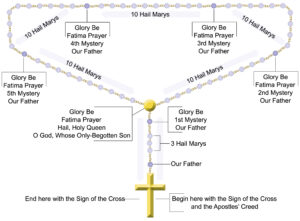 Many of our study groups like to conclude discussions of Scripture & the Rosary: New Testament Mysteries, Old Testament Parallels by praying a decade of the Rosary devoted to the Mystery that’s the focus of their lesson. A number of Catholics include a request for an increase in the spiritual fruit associated with the mystery. You can find out what’s associated with the Third Glorious Mystery in the “Fruits of Prayer” box on page 73 in Scripture & the Rosary: New Testament Mysteries, Old Testament Parallels.
Many of our study groups like to conclude discussions of Scripture & the Rosary: New Testament Mysteries, Old Testament Parallels by praying a decade of the Rosary devoted to the Mystery that’s the focus of their lesson. A number of Catholics include a request for an increase in the spiritual fruit associated with the mystery. You can find out what’s associated with the Third Glorious Mystery in the “Fruits of Prayer” box on page 73 in Scripture & the Rosary: New Testament Mysteries, Old Testament Parallels.
 We invite you to pray along with Turning to God’s Word co-founder Tami Palladino and her daughter Anne Marie on their prayer video featuring the Third Glorious Mystery of the Rosary. The prayers and videos for all 20 mysteries are accessible year-round at how to pray the Rosary, and you can access a link to Tami and Anne Marie’s how-to video to learn what’s important about praying the Rosary. Clicking on the diagram (above) will take you to the website page with the Rosary prayers.
We invite you to pray along with Turning to God’s Word co-founder Tami Palladino and her daughter Anne Marie on their prayer video featuring the Third Glorious Mystery of the Rosary. The prayers and videos for all 20 mysteries are accessible year-round at how to pray the Rosary, and you can access a link to Tami and Anne Marie’s how-to video to learn what’s important about praying the Rosary. Clicking on the diagram (above) will take you to the website page with the Rosary prayers.
Lesson 20 I Go to Prepare a Place for You (the Fourth Glorious Mystery, the Assumption)—the Gospel According to John 14:1–11 and the Book of Judith 13:15–20
Lesson 18 Why Do You Stand Looking into Heaven? (the Second Glorious Mystery, the Ascension)—the Acts of the Apostles 1:6–11 and the Second Book of the Kings 2:6–14
you also may like our two-part study of the prophets
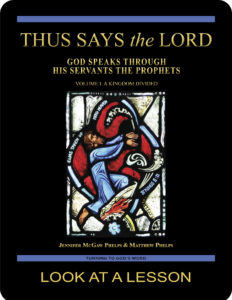
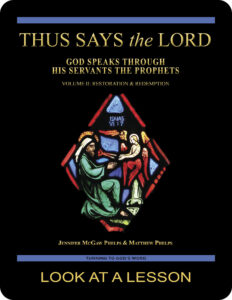 Thus Says the LORD: God Speaks Through His Servants the Prophets—Volume I: A Kingdom Divided examines the prophets in their historical context using the First and Second Books of the Kings and other Old Testament passages written before the Babylonian Exile in 586 B.C. Volume II: Restoration & Redemption looks at the post-exilic prophets. This 51-lesson Catholic Bible study builds on The United Kingdom of Israel: Saul, David & Solomon Foreshadow Christ the King. Click on the books’ covers to view a sample lesson from each volume.
Thus Says the LORD: God Speaks Through His Servants the Prophets—Volume I: A Kingdom Divided examines the prophets in their historical context using the First and Second Books of the Kings and other Old Testament passages written before the Babylonian Exile in 586 B.C. Volume II: Restoration & Redemption looks at the post-exilic prophets. This 51-lesson Catholic Bible study builds on The United Kingdom of Israel: Saul, David & Solomon Foreshadow Christ the King. Click on the books’ covers to view a sample lesson from each volume.
start a Turning to God’s Word Bible study
 Thank you for your interest in Scripture & the Rosary: New Testament Mysteries, Old Testament Parallels.
Thank you for your interest in Scripture & the Rosary: New Testament Mysteries, Old Testament Parallels.  Information about beginning a Turning to God’s Word Bible study can be found at start a Bible study. Tami, Matthew, and I are available to answer your questions and to offer support. You may use this email to contact us directly if you’re interested in starting a Turning to God study or in having your study schedule listed with other TtGW study groups on our website. —Jennifer
Information about beginning a Turning to God’s Word Bible study can be found at start a Bible study. Tami, Matthew, and I are available to answer your questions and to offer support. You may use this email to contact us directly if you’re interested in starting a Turning to God study or in having your study schedule listed with other TtGW study groups on our website. —Jennifer
*There are seven deuterocanonical books in the Old Testament—the Books of Tobit, Judith, Wisdom, Sirach, Baruch, and First and Second Maccabees, as well as some passages in the Books of Esther and Daniel. Protestants usually refer to these works as “apocryphal,” a word that means “outside the (Protestant) canon” because they’re excluded from most Protestant Bibles. The word “deuterocanonical” means “second canon”; Catholics use that word to refer to any section of the Catholic Old Testament for which there are no extant, or existing, Hebrew manuscripts. All of the deuterocanonical books appear in the Septuagint, the earliest remaining versions of which date to the 1st century B.C. This Greek translation of the Old Testament was in common use by Jews at the time of Jesus—but the same books aren’t found in existing Hebrew manuscripts, which aren’t as old as the oldest version of the Septuagint. Learn more by reading How Do Catholic & Protestant Bibles Differ?
Turning to God’s Word printed Bible studies use the 2006 Revised Standard Version Second Catholic Edition (RSV2CE) translation for all Scripture references except those to the Psalms, which are taken from The Abbey Psalms and Canticles, prepared by the Benedictine monks of Conception Abbey and published in 2020 by the United States Conference of Catholic Bishops (USCCB). All Scripture links for the digital version of Scripture & the Rosary: New Testament Mysteries, Old Testament Parallels are to the 1966 Revised Standard Version Catholic Edition (RSVCE) translation. The New International Version (NIV) audio recordings follow the same chapter and verse numbering as the RSV Catholic translations, but the NIV translation doesn’t include the deuterocanonical books and passages.
The 1966 RSVCE uses archaic pronouns and verb forms such as “thee,” “thou,” “didst” in the Psalms and in direct quotations attributed to God. The 2006 RSV2CE replaces those with more accessible English. The few significant translation changes in the RSV2CE include rendering almah as “virgin” in the Book of Isaiah 7:14 and restoring the term “begotten” in the Gospel According to John 3:16.
Numbering varies for some passages in this Bible study. Turning to God’s Word studies follow the numbering in the Revised Standard Version Catholic translations (RSV2CE and RSVCE). Discrepancies in the New American Bible Revised Edition (NABRE) are noted in the Index of Scripture Citations.
 You can learn more about the Psalms by viewing a sample lesson from the Turning to God’s Word Catholic Bible study Sing a New Psalm: Communicating with God Through the Prayers of the Church—Volume I: Lauds & Vespers. The second part of that study, Sing a New Psalm: Communicating with God Through the Prayers of the Church—Volume II: Vigils, Day Prayer & Compline, is scheduled for publication in 2025. Some verse numbers may vary in different translations of the Psalms.
You can learn more about the Psalms by viewing a sample lesson from the Turning to God’s Word Catholic Bible study Sing a New Psalm: Communicating with God Through the Prayers of the Church—Volume I: Lauds & Vespers. The second part of that study, Sing a New Psalm: Communicating with God Through the Prayers of the Church—Volume II: Vigils, Day Prayer & Compline, is scheduled for publication in 2025. Some verse numbers may vary in different translations of the Psalms.
